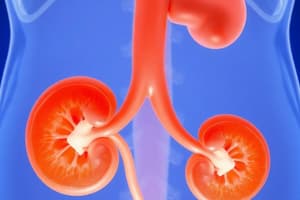Podcast
Questions and Answers
What is the purpose of evaluating renal function in children?
What is the purpose of evaluating renal function in children?
- For routine, diagnostic, and prognostic purposes (correct)
- To assess lung function
- To evaluate liver enzymes
- To measure the heart rate
How can Glomerular filtration rate (GFR) be estimated?
How can Glomerular filtration rate (GFR) be estimated?
- By using height in cm and a constant value (correct)
- By analyzing the odour of the urine
- By evaluating the appearance of the urine
- By measuring protein levels in the blood
In urinalysis, what parameter is examined to determine the presence of glucose?
In urinalysis, what parameter is examined to determine the presence of glucose?
- Glucose (correct)
- pH
- Specific gravity
- Protein
Which type of cells in the urine indicates glomerular origin?
Which type of cells in the urine indicates glomerular origin?
What method can be used to evaluate renal function radiologically?
What method can be used to evaluate renal function radiologically?
What is the prevalence of end stage renal disease (ESRD) worldwide due to congenital anomalies of the kidney and urinary tract (CAKUT)?
What is the prevalence of end stage renal disease (ESRD) worldwide due to congenital anomalies of the kidney and urinary tract (CAKUT)?
Which of the following is NOT a type of anomaly that can occur in the kidney, ureter, bladder, and urethra?
Which of the following is NOT a type of anomaly that can occur in the kidney, ureter, bladder, and urethra?
What percentage of the pediatric population accounts for progression to end stage renal disease (ESRD) due to congenital anomalies of the kidney and urinary tract (CAKUT)?
What percentage of the pediatric population accounts for progression to end stage renal disease (ESRD) due to congenital anomalies of the kidney and urinary tract (CAKUT)?
Which congenital anomaly can be antenatally detected?
Which congenital anomaly can be antenatally detected?
Which of the following is NOT a diagnosis associated with congenital anomalies of the kidney and urinary tract (CAKUT)?
Which of the following is NOT a diagnosis associated with congenital anomalies of the kidney and urinary tract (CAKUT)?




